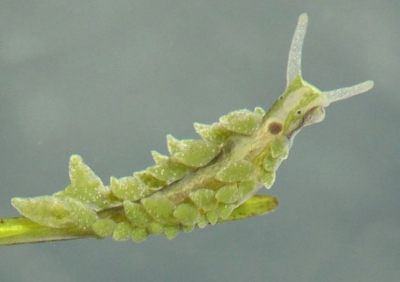

Ercolania cf viridis
Order: SACOGLOSSA
Superfamily: LIMAPONTIOIDEA
Family: Limapontiidae
DISTRIBUTION
Bassin d'Arcachon, Atlantic coast of France.
PHOTO
Locality: "L'Ecluse de Verdurette", Domaine de Graveyron, Audenge, Bassin d'Arcachon, 1 m, France, Atlantic: Green animal: 25 August 2006, Length: animal 8 mm; eggs 3 and 4 mm. Black animal: 4 September 2006, 6 mm; eggs 5 mm. Photographer: Marina Poddubetskaia .
This species ranges in colour from green to black and seems to have slightly raised whitish tubercles on its cerata. It is quite similar in appearance to Ercolania viridis, but its egg ribbon seems quite different from that illustrated on the Forum for that species [see message #8300]. Kathe Jensen [message #22386] says that such egg differences are also found in E. nigra.
See further discussion in the messages below which show a range of animals photographed by Marina Poddubetskaia Ossokine. I have decided to keep these separate from 'typical' E. viridis until we have some confirmation that these are all one species.
Authorship detailsRudman, W.B., 2009 (April 2) Ercolania cf viridis [In] Sea Slug Forum. Australian Museum, Sydney. Available from http://www.seaslugforum.net/find/ercocfviri
Related messages
Re: Calliopaea bellula - Ercolania cf. viridis & eggs
April 6, 2009
From: Marina Poddubetskaia Ossokine
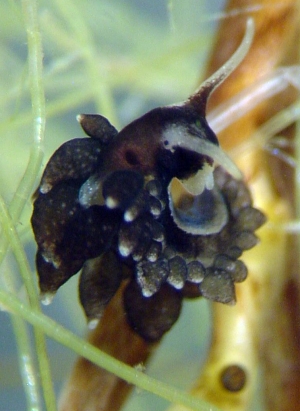
Concerning message #22387:
Dear Kathe and Bill,
To come back to the question of the dark band on the foot sole, I have only a partial view of the black animal sole and it's possible this band exists.
The sole of the green animals hasn't any band (middle photos - the same 8 mm animal as in message # 22367 ).
And to confirm the hypothesis they are a colour range of one same species, the bottom photos shows a pale black colour form, intermediate between green and black animals. Unfortunately I haven't photos of its eggs or a ventral view.
Locality: "L'Ecluse de Verdurette", Domaine de Graveyron, Audenge, Bassin d'Arcachon, 1 m, France, Atlantic: 4 September 2006, Upper animal: 5 mm. Lower animal: 6 mm. Photographer: Marina Poddubetskaia .
I have few specimens of this species and I will collect and sample it more as soon as I could. And I hope one day this ID will be firmly confirmed.
Best wishes,
Marina.
Nembro website
nembro@yahoo.fr
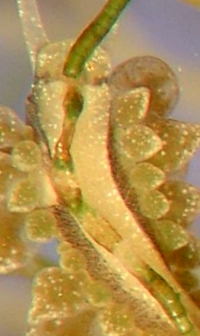
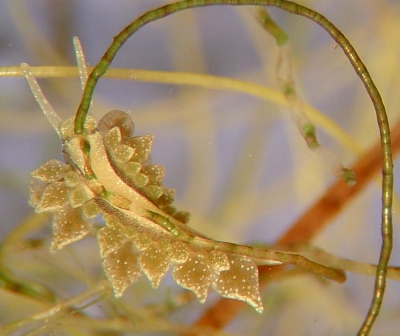

Thanks Marina,
I suspect this will take a while to sort out. The first job will be to sort out just how many species there are and the second job will be to investigate all the old names and decide how many are identifiable and to which of the actual living species they refer. Unfortunately some of the older workers did not have a good idea of colour variability within a species or conversely they did not realise that there could be a number of species which looked almost identical to each other.
I am sure that detailed studies and photos of common species such as you are accumulating, will be of great assistance in solving these puzzles.
Another interesting thing I noticed in your middle photos of the green animal was that it appears to be feeding. You will notice that the algal filament it is on is a uniform green above its head but below the cell contents have been disrupted suggesting to me that it is gradually sucking them out. In the background there is another algal filament with the same apparent damage.
Best wishes,
Bill Rudman
Re: Calliopaea bellula - Ercolania cf. viridis & eggs
April 2, 2009
From: Kathe Rose Jensen
Concerning message #22386:
Dear Bill,
Sorry I missed the egg mass question. However, egg masses of Ercolania nigra are highly variable. Sometimes they will produce 2-3 small egg masses per day shaped like those in Marina's pictures [#22366]. Sometimes one large egg mass every second day, shaped like the one in Alexander's picture from the Black Sea [message #8300 ].
I have never noticed orange tips of the cerata, so I think that must be a photographic illusion. White tips are sometimes present as are the tiny white dots (dermal mucus glands?).
At one time Kerry Clark also thought that there were two species of "Ercolania funerea" in Florida - also with different egg masses, and I know there are two species of "Ercolania boodleae"/ "E. emarginata " in Hong Kong - one with white tips and one with orange or white tips of the cerata. I tried to do fertility experiments in the lab. and one specimen didn't want to copulate with any others until I got a partner that matched. But since I couldn't tell them apart externally, I don't know which of the preserved specimens are which species. So maybe Marina and others should try to observe copulation between green and dark specimens. It would certainly help if we could just separate them on coloration.
Best wishes,
Kathe
krjensen@snm.ku.dk
Jensen, K.R., 2009 (Apr 2) Re: Calliopaea bellula - Ercolania cf. viridis & eggs. [Message in] Sea Slug Forum. Australian Museum, Sydney. Available from http://www.seaslugforum.net/find/22387Dear Kathe,
I know there is evidence that some species change development types, but these two egg masses are so different that I find it difficult to believe they are produced by the same species. It's not whether the black and green animals are the same species - if the egg masses do reflect two species then both species have a green and black form. Certainly the series of photos Marina has sent us show that the species laying the sausage-shaped egg masses ranges from black to green. I remember looking at the old literature when Alexander sent his Black Sea photos and I am happy with the identification of that animal as Costa's E. viridis [=E. funerea]. If Marina's is a different species, there seem to be about 6 names for Ercolania and Ercolania-looking species which have been named from the Mediterranean and nearby waters. Perhaps one of those will need to be resurrected. Clearly stage 1 would be to see if Marina's animals ever lay Alexander-type eggs.
I think I will keep Marina's animals on an Ercolania cf viridis page so that the two 'forms' don't get even more confused
Best wishes,
Bill Rudman
Re: Calliopaea bellula - Ercolania cf viridis & eggs [4]
March 31, 2009
From: M. Poddubetskaia Ossokine

Concerning message #22350:
Bill,
To complete my previous messages about Ercolania viridis [#22366; #22367; #22378], here is a set of photos, of another slightly different 'Ercolania viridis'.
Locality: "L'Ecluse de Verdurette", Domaine de Graveyron, Audenge, Bassin d'Arcachon, 1m, France, Atlantic, 4 September 2006. Length: Animal 11 mm; eggs 3 and 5 mm. Photographer: Marina Poddubetskaia.
Best wishes,
Marina.
Nembro website
nembro@yahoo.fr

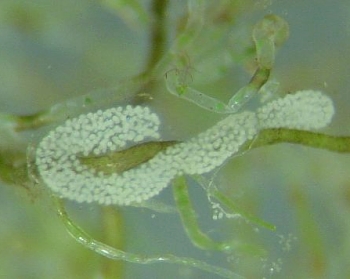
Thanks Marina,
I suspect all the animals in your series of photos are the same species, but hopefully we will get a more expert response.
Best wishes,
Bill Rudman
Re: Calliopaea bellula - Ercolania cf. viridis & eggs [3]
March 31, 2009
From: M. Poddubetskaia Ossokine
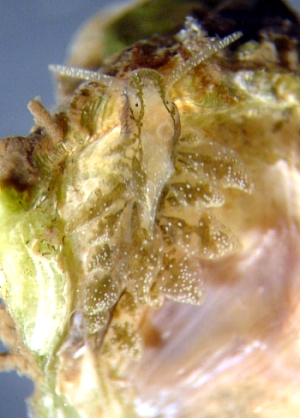
Concerning message #22350:
Bill,
To complete my previous messages about Ercolania viridis [#22366; #22367], here is another set of photos, of a slightly different 'Ercolania viridis' [see also message #22379].
Locality: "L'Ecluse de Verdurette", Domaine de Graveyron, Audenge, Bassin d'Arcachon, 1m, France, Atlantic, 4 September 2006. Length: Animal 8 mm; eggs 4 mm . Photographer: Marina Poddubetskaia.
Best wishes,
Marina.
Nembro website
nembro@yahoo.fr

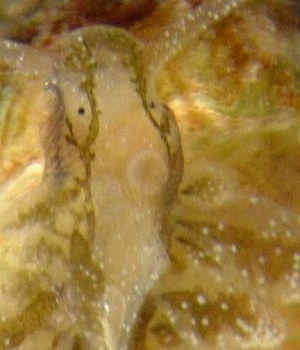
Thanks Marina,
Best wishes,
Bill Rudman
Re: Calliopaea bellula - Ercolania cf. viridis & eggs [2]
March 31, 2009
From: M. Poddubetskaia Ossokine

Concerning message #22350:
Bill,
To complete my previous message about Ercolania viridis [#22366 ], here is a second set of photos, of a slightly different 'Ercolania viridis' [see also messages #22378, #22379].
Locality: "L'Ecluse de Verdurette", Domaine de Graveyron, Audenge, Bassin d'Arcachon, 1m, France, Atlantic, 4 September 2006. Length: Animal 8 mm; eggs 3 mm. Photographer: Marina Poddubetskaia.
Best wishes,
Marina.
Photos: Marina Poddubetskaia - Nembro website
Marina Poddubetskaia
nembro@yahoo.fr
nembro@yahoo.fr

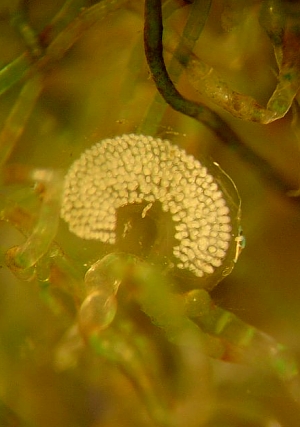
Thanks Marina,
Best wishes,
Bill Rudman
Re: Calliopaea bellula - Ercolania cf. viridis & eggs [1]
March 31, 2009
From: M. Poddubetskaia Ossokine
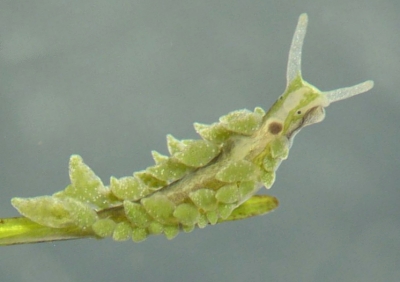
Concerning message #22350:
Dear Bill,
To answer your question about Ercolania viridis eggs, I agree it is different from the photos on the Forum and the best I could do is to produce proof of it in a series of photos.
Before, I'd like to specify that all the Calliopaea and Ercolania photos were taken at my home. The eggs were laid at home too. The algae are from original environment and these animals were found on them. These species were found in a muddy shallow place with approx. 20 cm of visibility (another kind of extreme diving :-) so any photo in situ was completely out of the question.
Here is the first series of photos, those of typical Ercolania viridis:
- Green animal and the related eggs [upper & middle left photos ]: please, note that the egg-mass shape is different from one alga to another.
- Blackish animal and the related eggs [middle right and lower photos]: a black colour form, with eggs completely different from Alex Kurakin's message but similar to that eaten by Calliopaea in my earlier message.
I didn't photograph Ercolania viridis on 9th October (when I photographed Calliopaea bellula ) but they were present and I used their eggs to experience Calliopaea feeding. In a separate message I will send you the animals I'm calling Ercolania cf. viridis with slightly different cerata and egg-ribbons.
Locality: "L'Ecluse de Verdurette", Domaine de Graveyron, Audenge, Bassin d'Arcachon, 1 m, France, Atlantic: Green animal: 25 August 2006, Length: animal 8 mm; eggs 3 and 4 mm. Black animal: 4 September 2006, 6 mm; eggs 5 mm. Photographer: Marina Poddubetskaia .
Best wishes,
Marina.
Nembro website
nembro@yahoo.fr
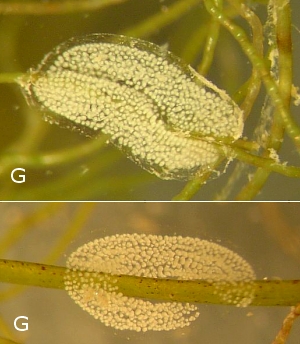


Dear Marina,
Thanks for this valuable series of photos. So that we can see all the detail, I have split your other photos, which you think may be something slightly different, into a series of separate messages [#22367, #22378, #22379]. What I was querying in my earlier comments was not whether you had correctly matched the eggs to this species, but whether this species is actually Ercolania viridis. As you will have noted from earlier messages on the Forum, the identity of Ercolania viridis has caused some problems which your specimens and their egg ribbons suggest have still not been satisfactorily resolved. As Kathe Jensen discusses, the green Ercolania viridis Costa, 1866 and the black Ercolania funerea Costa 1867 are colour forms of a single species [see message #10165 ].
In your green animal we can see traces of black pigmentation on the sides of the body and both the green and black animals have whitish pustules on the cerata which support your suggestion that they are the same. The egg masses of your animals, however, are so different from those of the earlier ones [messages #8300, #9853] that they must almost certainly be different species. So is your animal Costa's E. viridis or is the one already on the Forum that species?
Hopefully Kathe Jensen can give us some ideas.
Best wishes,
Bill Rudman
